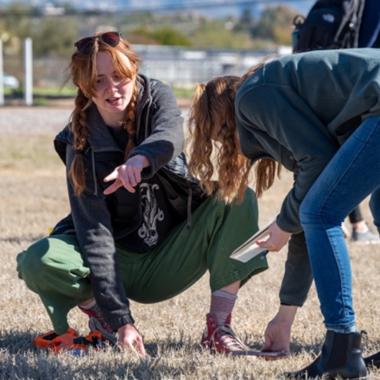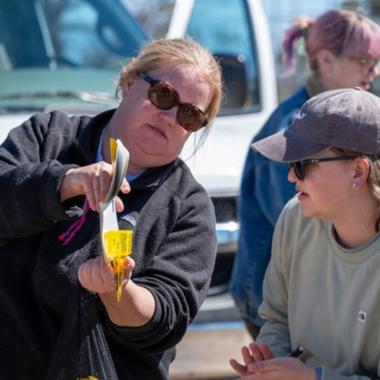A Student’s Perspective: The significance of field trips in environmental science education
ENVS graduate student, Ben Yang, shared his experience as the teaching assistant and photographer leading field trips with Dr. Katrina Henry in ENVS430: Environmental Monitoring and Remediation.
As an undergraduate student, I always looked forward to field trips. The sunshine, breeze, and rustling leaves provided a comfortable learning environment, and I found that I could learn surprisingly well even without being fully focused or taking notes in the classroom.
The more field trip opportunities available may have been an important reason why I chose to study environmental biology instead of chemistry or physics. Now, as a teaching assistant, I have gained some new insights into using field trips as a learning tool.
Picture2.jpg

Instructors want students to do more than just remember content and follow instructions. L. Dee Fink (2013) groups this larger learning focus into six "significant learning categories": foundational knowledge, application, integration, human dimension, caring, and learning how to learn. As a highly interdisciplinary department devoted to addressing real-world challenges, achieving these significant learning outcomes becomes extremely important.
Dr. Katrina Henry, the instructor for ENVS 430, often walks students through the background information of the field trip in class and then takes students to the field to apply what they have learned. Application in the real world always brings surprises. For example, in the rain gauge lab we had at the Campus Agricultural Center, a sprinkler was installed to simulate a precipitation event, and students deployed rain gauges with two different sampling designs (simple random vs. stratified random) to investigate the "precipitation" distribution. In Excel, generating a series of coordinates is as simple as using two columns of the RANDBETWEEN function. But in the field, converting those numbers into meaningful locations with a tape measure and compass is not a simple task. It requires students to think about potential sources of error and to work together as a team.
In previous semesters, we used to take students on field trips to Tres Rios Water Reclamation Facility and Biosphere 2. Even the most well-designed lecture on sewage treatment cannot leave as deep an impression as visiting a sewage treatment plant in person. In the future, we plan to add more field trips to potential employers for ENVS students to provide a networking opportunity with companies and better prepare them for the job market. Dr. Henry is welcoming any alumni want to share their awesome working place and their wisdom.
Picture3.jpg

The surprises in real-world experiments not always bring challenges but sometimes discoveries. In this semester, we set up a weather station on campus to monitor plant water stress, using an infrared radiometer and temperature and relative humidity sensors to estimate the crop water stress index (CWSI). An abnormal drop in CWSI was found in the middle of the night on March 2nd. The unexpected snow dramatically lowered the canopy temperature of the plants we monitored. The empirical model we used attributed that temperature drop to fast plant transpiration and mistakenly inferred the low water stress status. This source of error had never been reported in the user's manual or instructions from the sensor manufacturer – surprisingly cool finding!
While the learning outcomes mentioned above can be achieved through various teaching methods, field trips provide a unique opportunity to foster the "human dimension" and "caring" that are often difficult to achieve in the classroom.
Our field trips are organized as "field partners" or groups. Apart from the necessary collaboration to finish the lab objectives, such as the example in the rain gauge lab, mutual help among students sometimes presents itself in a dramatic way. For example, Aden lost one of his slippers in the quicksand at Santa Cruz River. Thanks to the efforts of his classmates, we successfully reclaimed his slipper!
What is more important, environmental science students need to embrace a sense of mission. Our knowledge and skills are used to identify and apply solutions to human-environmental challenges. The best way to do that is to let our students experience the magic and beauty of nature, appreciate and respect the existence and diversity of non-human neighbors sharing the same planet with us.
Picture6.jpg



